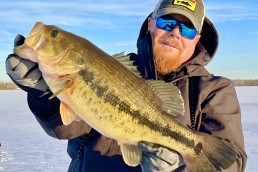The Age of First Ice
SHARE THIS POST
First ice can be some of the best ice fishing of the year.
On the days when nothing is moving in the woods, avid anglers are looking at the frozen ponds, wondering why they’re sitting in a deer stand while there is ice. Grouse, ducks and deer are exciting—but in a hardcore ice angler’s world, ice fishing wins the race!
Following the ice age
First ice can be some of the best ice fishing of the year. The age of ice in Minnesota varies from north to south. It can be 10 to 20 degrees warmer in southern Minnesota than northern Minnesota. The same applies to the Dakotas, Wisconsin and more. It’s all about latitude! The ice is obviously thicker and older in areas where the temperature is lower, and shallow lakes and bays freeze first.
Please follow ice safety instructions: Bring a tape measure, flotation, etc.
I enjoy checking ice around the state with my safety gear in hand. When I find four inches of clear ice, I follow it in hopes of reaching a fishable spot. It’s simply an extension of the fall bite under a sheet of ice! This makes the hard work and all the chiseled and drilled holes worth it.
Catch what I want or what is biting?
When the ice is safe on Upper Red Lake, anglers don’t mind dragging out gear in Otter sleds because the walleye bite is great for all sizes of fish. The reward for the walk is a fresh meal of walleye at the end of the day. Windy days on Upper Red can push new ice around and completely open up the lake, so the freezing process has to restart.
Keep your mind open to other great bites that are available in your area. Since shallower lakes freeze first, I am more than happy to target what is available to catch on those bodies of water. I have enjoyed catching first-ice largemouth bass, northern pike, jumbo perch and some shallow-lake bluegills and crappies. As deep waters freeze, we can target walleyes.
There are a few tricky spots around the Midwest where anglers fish on small bays off main lakes, sloughs and oxbows, six feet from shore, and even between boat harbor docks. You don’t need a machine to access these areas. Early ice on foot is stealthy with minimal ice fishing gear. No machine or boat payment are necessary. This is one of the reasons why it’s one of the fastest-growing segments of fishing. It’s an affordable outdoor activity for the whole family.
Are you enjoying this post?
You can be among the first to get the latest info on where to go, what to use and how to use it!
My new favorite spot
All fish have reasons why they inhabit specific early-ice spots. Forage is number one, followed by cover. But sometimes, we can’t be there when they are actively feeding or schooled up.
Some areas, like weeds, rocks and moderate-depth basins, will load up with schools of crappies or bluegills. Other areas will have walleyes. If you are not finding fish, don’t just look to the middle or other side of the lake. You may have already walked past the fish on your way out.
For example, walleye fishing is often slow. No one is catching any on any spot. Then, three or four days later, everyone is catching walleyes on that same shoreline break. Then you find out that somebody hammered them on the inside of the drop, even inside the weeds, in 2 to 4 feet of water!
Another example: Crappie and panfish anglers may be set up in the usual first basin spot, punching hole after hole, and finding nothing but tiny perch and a few micro-crappies. They later find out the fish were hiding in dense weed mats that were frozen and hanging from the ice in shallow water.
There is nothing more fun than finding a school of fish where no one else is fishing. Wherever I find them is my new favorite spot!
For more ice fishing insight from the pros who know, check out the winter issues of MidWest Outdoors, available by subscribing on our website.
MWO
SHARE THIS POST
You may also like...
Nothing found.
Did you enjoy this post?
You can be among the first to get the latest info on where to go, what to use and how to use it!
Brian 'Bro' Brosdahl
Outdoor communicator Brian “Bro” Brosdahl lives in northern Minnesota. He is a walleye guide in the Cass Lake, Leech Lake and Lake Winnibigoshish areas. He is sponsored by Northland Fishing Tackle, Frabill/Plano, Aqua-Vu, Humminbird/Minn Kota, St. Croix Rods, Ranger Boats, and Evinrude. Guide inquiries: brosguideservice.com. Follow on social media.
